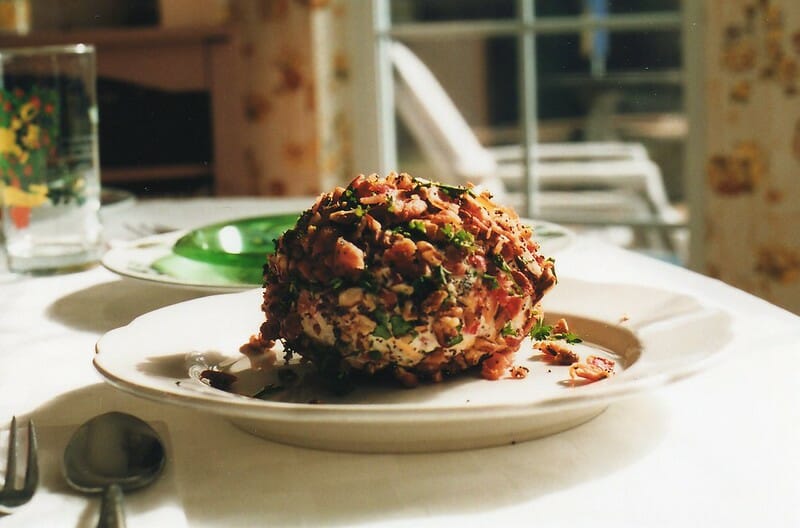Instead of salmon, consider using invasive brook trout or rainbow trout in a holiday cheeseball like the one above. Photo courtesy of Flickr.com.
Like most avid fly fishers, I release most of the fish I catch. But for several reasons, I have stopped looking at fishing from a numbers perspective, and I’m harvesting more fish than I usually do, but I’m doing so for good reasons.
Here in the West, one of the greatest threats to our native cutthroat trout is the presence of invasive species — brook trout have taken over many a high-country trout stream from native fish, and some of our big-water cutthroat trout habitat is under serious threat from rainbow trout (rainbows and cutthroats can spawn together in the spring and produce a fertile hybrid). So, of late, I’ve made it a point to actually target these non-native fish and harvest them for the smoker or the grill.
Often, state fish and game agencies encourage anglers to harvest invasive trout or char — limits are either non-existent or they’re very liberal. Such is the case here in my corner of Idaho, where the brook trout limit is a whopping 25 (with a few exceptions where brookies are part of a trophy fishery). Also, on the South Fork of the Snake River, anglers are encouraged to harvest rainbow trout, and there is no official limit on these fish, some of which can exceed 18 or 20 inches and are big enough to actually filet.
I have quite a few fish in the freezer, and with the holidays approaching, it’s a great time to defrost some of the trout and put them to use in some festive recipes. I have a few dozen smoked brookies frozen in vacuum packs that I set aside just about every year for my favorite holiday recipe. I’ve even gotten requests from friends who expect me to bring this dish to parties, or to have it on hand if we gather at here at our house to celebrate the season.
My “brook trout paté” isn’t really a paté, but more of a cheeseball featuring smoked brookies. It’s also easy to make, and, as I tell my friends, by enjoying some, they’re doing their part and helping remove invasive fish from our rivers that threaten the long-term survival of native cutthroat trout.
Here’s the recipe:
What you’ll need
- Six to eight (depending on size) cleaned brook trout. Removal of the heads and tails is optional
- Two bricks of cream cheese
- Two tablespoons of minced garlic
- Half an onion, finely chopped
- Handful of fresh chives
- Half a tablespoon of dill
- One quarter cup of rolled or finely chopped almonds and/or cashews
- One teaspoon each of salt and pepper
- Your favorite crackers — the sturdier, the better
Smoking your trout
The first step is the most important … and the most time-consuming. You need to smoke your brook trout. Here’s how I do it.
- Most of the brookies I catch are between 6 and 10 inches long. I “brine” the trout in a freezer bag overnight, usually in a solution that includes something salty, like teriyaki sauce, soy sauce or even Worcestershire sauce. Often, I’ll throw in some brown sugar or some citrus, too. It’s totally up to you.
- I have a small electric smoker that works great for fish. I’ll lay the fish out on the grates above the heating element and then soak some alder chips in a cast-iron tray below the fish. I let it smoke on medium heat (about 190 to 220 degrees) for about three or four hours.
Building your cheeseball
- Once the fish are smoked, take a fork and pull the smoked meat from the bones. By this point, the flesh should be flaky and come off the bone easily. Discard the skeletal remains of the fish.
- About an hour before the smoking is done, take the two bricks of cream cheese out of the fridge and let them soften on the counter. In a pinch, you can toss the bricks in the microwave, but letting them soften over an hour or so is best.
- Take your brook trout flakes and combine them with all the ingredients except for the nuts and then fold the whole mixture in with the cream cheese. Mix well. The mixture should make two “balls” about the size of little league baseballs.
- Spread your rolled or chopped nuts out on a cutting board, and roll each ball in the almonds or cashews to coat the outside.
- Wrap your cheeseball in plastic wrap and either freeze it for later use or put it the fridge until you’re ready to put it out for folks to enjoy.
Serving
You can simply put the cheeseball on a small serving dish, or, in keeping with the holidays, present it with some garnish, like cranberries. I like to put it atop a few leaves of fresh spinach (it makes cleanup easier, honestly). I usually take it out of the refrigerator about an hour before serving so it softens a bit and folks don’t break their crackers trying to get at it.



